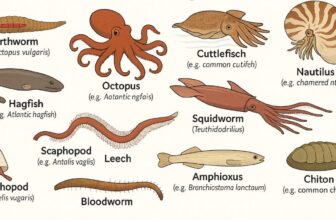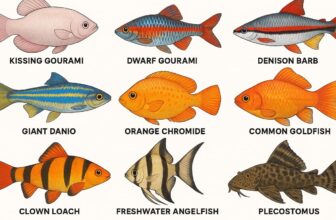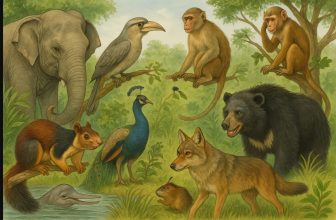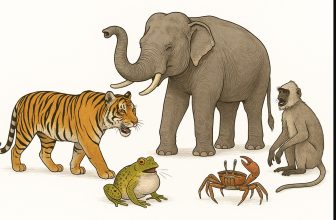You’re surrounded by modern creatures, but did you know that some animals walking (or swimming) around today are practically living fossils? These survivors have outlived dinosaurs, ice ages, and mass extinctions barely changing over millions of years. In this post, you’ll meet 13 ancient animals that still roam the Earth today and learn how they’ve stood the test of time.
1. Horseshoe Crab – 450 Million Years Old
You might confuse it with something from a sci-fi movie, but the horseshoe crab has existed for over 450 million years. Despite its name, it’s more closely related to spiders and scorpions. Found along the coasts of Asia and the Americas, it has blue blood that’s medically valuable for detecting toxins.
2. Coelacanth – 400 Million Years Old
This deep-sea fish was thought to be extinct until one was found off the coast of South Africa in 1938. You’re looking at a species that lived alongside the earliest land animals. With lobed fins that resemble limbs, it offers clues about the water-to-land transition in evolution.
3. Nautilus – 500 Million Years Old
With its spiral shell and tentacled body, the nautilus has barely changed in half a billion years. These marine creatures still float in the Indo-Pacific using jet propulsion, just as they did before the dinosaurs even existed.
4. Crocodile – 200 Million Years Old
If you’ve ever seen a crocodile, you’ve seen a prehistoric predator in action. Crocs appeared during the late Triassic period and haven’t changed much since. Their ability to survive both in water and on land has helped them weather multiple extinction events.
5. Sharks – 400+ Million Years Old
Sharks are older than dinosaurs, trees, and even insects. Modern species like the great white and hammerhead evolved more recently, but their ancestors go back over 400 million years. Their simple yet effective design has allowed them to dominate the oceans for ages.
6. Lamprey – 360 Million Years Old
This jawless, eel-like parasite hasn’t changed much since the Devonian period. Instead of biting, lampreys latch onto fish with a sucker-like mouth and feed on blood. You’ll find them in both freshwater and saltwater around the world.
7. Tuataras – 250 Million Years Old
You might mistake it for a lizard, but the tuatara is the only living member of an ancient reptile order that existed with the earliest dinosaurs. Native only to New Zealand, it has a “third eye” on top of its head used to detect light.
8. Sturgeon – 200 Million Years Old
If you’ve eaten caviar, you’ve tasted sturgeon eggs. These massive, bony fish date back to the time of the first mammals. Found in rivers and seas of Europe and North America, sturgeons can live over 100 years and grow up to 6 meters long.
9. Giant Freshwater Stingray – 100+ Million Years Old
The giant freshwater stingray, found in rivers like the Mekong, is a reminder that not all ancient creatures live in the sea. Weighing up to 600 kg, it uses its flattened body to hide on the riverbed, a strategy that’s worked for millions of years.
10. Okapi – 10-20 Million Years Old
Though it looks like a cross between a zebra and a giraffe, the okapi is a relic from a time when the giraffe family had more members. Native to the dense forests of the Congo, this shy, ancient mammal was only officially discovered in the early 1900s.
11. Goblin Shark – 125 Million Years Old
This deep-sea predator is known for its extendable jaw and eerie appearance. Often called a “living fossil,” the goblin shark lurks in deep waters and rarely comes to the surface, which is likely one reason it’s survived so long.
12. Crinoids (Sea Lilies) – 500 Million Years Old
Often mistaken for plants, these flower-like sea animals have been around since the Cambrian period. Some crinoids still attach themselves to rocks like their ancient ancestors, while others float freely in the ocean.
13. Bactrian Camel – 2 Million Years Old
This hardy desert survivor has roamed Central Asia since the Ice Age. With two humps and thick fur, it’s perfectly built for extreme cold and arid environments. Its endurance and adaptability have allowed it to survive where few animals can.
Why These Creatures Still Exist
These animals didn’t survive millions of years by luck. You’ll notice a few patterns:
- Low Competition Environments: Many live in extreme places like deep oceans or deserts.
- Simple, Effective Body Plans: Evolution didn’t need to “fix” what already worked.
- Slow Life Cycles: Many grow slowly, live long, and reproduce with care.
Instead of evolving rapidly, they’ve stayed the same and that’s what saved them.
Summary – Prehistoric Animals That Survived Mass Extinctions
| Animal Name | Age (Approx.) | Habitat | Key Trait |
|---|---|---|---|
| Horseshoe Crab | 450 million years | Coastal waters | Blue blood used in medicine |
| Coelacanth | 400 million years | Deep ocean | Thought extinct, rediscovered |
| Nautilus | 500 million years | Indo-Pacific oceans | Spiral shell and jet propulsion |
| Crocodile | 200 million years | Freshwater & coastal wetlands | Powerful jaw, unchanged design |
| Sharks | 400+ million years | Oceans worldwide | Evolved before dinosaurs |
| Lamprey | 360 million years | Freshwater and marine | Jawless bloodsucker |
| Tuatara | 250 million years | New Zealand | Third eye, not a true lizard |
| Sturgeon | 200 million years | Rivers & seas | Long-lived, caviar-producing fish |
| Giant Freshwater Stingray | 100+ million years | Asian rivers | Largest freshwater stingray |
| Okapi | 10-20 million years | Congo forests | Giraffe cousin, zebra-like stripes |
| Goblin Shark | 125 million years | Deep-sea | Extending jaw and eerie look |
| Crinoids | 500 million years | Ocean floors | Animal resembling a sea flower |
| Bactrian Camel | 2 million years | Central Asia deserts | Two humps, ice-age survivor |
You don’t need a time machine to see Earth’s ancient past. You just need to know where to look. From deep oceans to desert sands, these 13 creatures have quietly witnessed Earth’s transformations for millions of years and they’re still here, living proof of nature’s resilience.





